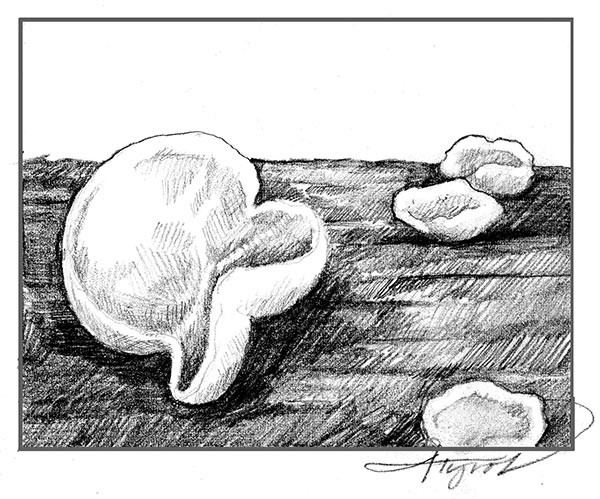
They look like blobs of shiny tar, a melted lollipop, or a crayon left in the sun too long. They come in vivid colors from orange to yellow to white to black to pinkish. They have a disconcerting ability to mimic human body parts, such as ears and tongues, with a Daliesque artfulness.
Jelly fungi.
They got their name because their tissues have the texture and consistency of, well, jelly. In some cases it’s more like rubber. The various species often carry imaginative common names: witch’s butter, snow fungus, jelly ear.
“They can often be very beautiful and very colorful, and the jelly-like mass represents the reproductive tissues that produce sexual spores,” said Professor Terrence Delaney, a biologist and mycologist who studies plant pathogens and teaches courses on fungi at the University of Vermont.
The fact that you can often find jelly fungi in the winter may give the false impression that they grow even in the coldest months. While there are so-called winter mushrooms that fruit late in the season, the frozen, colorful blobs that you see aren’t likely to be growing, explained Delaney. Rather, they’re remnants of jelly fungi that last formed in the cool, damp days of autumn, then froze in a cold snap. The organisms that created them, however, are very much alive. They survive the winter under the wood or other substrate on which the jelly clings.
The colorful gelatinous growths you see in the early spring are likely new growth, nourished by snowmelt and spring rains.
Despite appearances, the large group of jelly fungi are not a single family of closely related species. “They’re a tremendously diverse group,” said Delaney. “You’d be surprised at how two similiar appearing jelly fungi can be only distantly related. For example, two orange jelly fungi may be less closely related than are humans to hummingbirds.” The similar, gelatinous bodies of jelly fungi are an example of convergent evolution, where different organisms evolve independently and come to the same solution to a problem – in this case, to manage the vagaries of hydration and desiccation.
A jelly fungus’ microscopic sexual cells, called basidia, reveal more evidence of the differences within the group. In some, the cells are “Y-shaped,” like a tuning fork, while in others they are round but divided into chambers, like an orange with four wedges. These features, and consideration of whether their substrate is decaying hardwood or softwood, can help you identify different species of jelly fungi.
For scientists, jelly fungi pose some research challenges. For one thing, there’s getting the specimen home in decent shape. Another is preserving it. To identify a species and place it within a group of fungi is especially challenging during dry times of the year, when jelly fungi are nothing more than dry, scale-like stuff on logs or dying trees. But when it rains, their gelatin-like matrix absorbs moisture like a sponge. It’s an adaptation that allows the fungi to take almost instant advantage of wet spells. Rather than having to “build” new spore-producing components from scratch, like most cap mushrooms, jelly fungi just have to rehydrate their bodies.
Another interesting thing about jelly fungi: while many of them feed on decaying wood, some eat other fungi, a not uncommon thing among the mushroom clan. The Collybia jelly, Syzgospora mycetophila, for instance, preys on the common Gymnopus dryophilus mushroom. Witch’s butter, Tremella mesenterica, also known as golden brain, yellow trembler, and golden jelly fungus, is a parasite on the mycelium of a wood-decay fungus.
When it comes to getting eaten by humans, the jelly fungi don’t have much to worry about. Many species are edible, but most just don’t taste like anything, and have an unpleasant rubbery texture. The apricot jelly is a tongue-shaped fungus that’s sometimes harvested and sold. George Barron, in his Mushrooms of Northeast North America, noted that the distinctive apricot coloring really dresses up a mixed salad, but doesn’t contribute any taste.
While they’re not going to help feed the world, jelly fungi will continue to play their part in breaking down organic matter, and that’s no small thing.


Discussion *